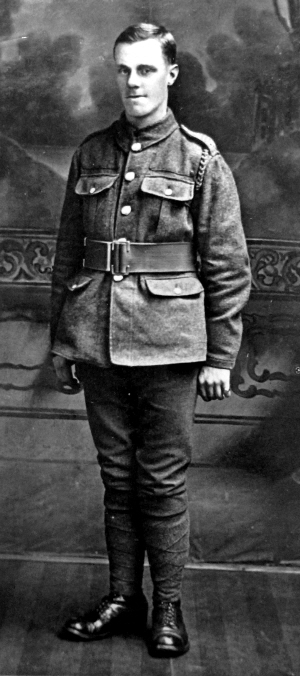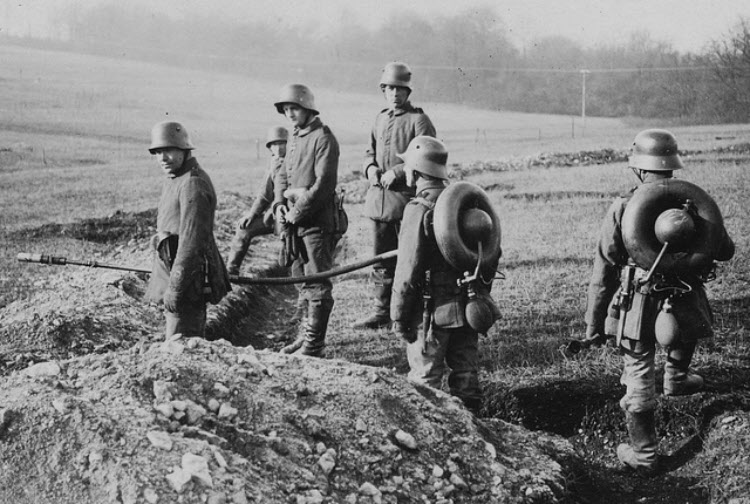
Fred Laycock was born in Ossett in Spring 1895, the only surviving child of Ossett coal miner Tom Laycock and his wife, Ravensthorpe-born Ada (nee Farnhill), who married in early 1883. The couple had three children from their marriage, but sadly two of those children died before April 1911.
In 1901, the couple were living on Hope Street, Ossett with their seven year-old daughter, Sarah, and 5 year-old son Fred. Sadly, Sarah Laycock died later that year and by 1911 Fred, now aged 15, was living with his parents at nearby 3, Cardigan Lane, Ossett. Tom Laycock was a coal miner and his son Fred was working as a colliery labourer, above ground, most probably at the nearby Old Roundwood Colliery.
On the 13th January 1917, at Gawthorpe and Chickenley Heath Parish Church, Fred Laycock married 21 year-old spinster Florence (Florrie) Firth. They appear not to have had any children from their marriage.
The record shows that in 1912, Fred joined the Territorial Force (T.F.) as a bugler in the 1st/4th Battalion of the King’s Own Yorkshire Light Infantry with a service number 4498. If this date was correct, it suggests that Fred may have been mistaken about his age, since he was only 16 years old at that time and consequently too young to sign on. In any event, on the 7th February 1916, perhaps at the end of his Territorial Force engagement, 20 year old Fred enlisted, at Ossett, to serve in the regular army for the duration of the war. He was posted to Army Reserve until the 14th April 1916 and more than a year later, on the 15th March 1917, he was posted to the Yorkshire and Lancashire Regiment and made Lance Corporal, with service number of 40251.
He embarked for France on the 7th June 1917, and the following day he joined the 9th Yorks and Lancs Regiment in the field. On the 27th June 1917, he transferred to the 2/6th Battalion, Manchester Regiment in the field, with service number 44867.
The 2nd/6th Battalion of the Manchester Regiment was formed at Manchester in August 1914 as a second line unit. In November 1914, the battalion was placed under command of 199th Brigade in 66th (2nd East Lancashire) Division. They moved to Crowborough in May 1915, went on to Colchester in March 1916 and in February 1917, landed in France. In April 1918, after taking heavy casualties, the battalion was reduced to cadre strength and on the 31st July 1918, they were disbanded in France.
The 2/6th Manchesters within the 199th Brigade of the 66th Division were involved in the battle of St Quentin between the 21st – 23rd March 1918. Their action on the 21st March was a brave and desperate defence against the German onslaught. North of Grand Priel Woods, the enemy was held up for some time by 2/6th Manchester Regiment in the area around Fervaque Farm, in the front line of the battle zone, opposite Villeret. They were eventually overcome by German flame thrower attacks. Two companies were eventually surrounded and only a handful escaped to join what was left of the other two. They had been at almost full strength before the attack. By the end of 21st March, they had been reduced to 162. Sixty had been killed, the rest wounded or prisoner.
By the evening of the 24th March, this had reduced to two officers and 34 men. During the 27th March, now only 21 strong, the battalion joined in a counter-attack which bought some more time and allowed a further withdrawal. Stragglers and those with minor wounds rejoined over the next couple of days, bringing the number up to just over 200. A divisional counter-attack was launched on the 31st March. It was unsuccessful and a further retreat was made. This was the last time the battalion saw action as a cohesive unit.
There was a short note in the “Ossett Observer” 1 reporting that Private Fred Laycock was missing in action:
“Private Fred Laycock, Manchester Regiment, a married man, residing at Tolson’s-buildings, Chickenley, who used to work at Bottomfield Mill, Ossett, is posted as missing from his regiment after engagements with the enemy towards the end of March.”
Fred Laycock was killed in the first day of the German Spring Offensive, Operation Michael, on the 21st March 1918 and his widow was subsequently awarded a pension of 12/9d per week. He had served in the regular army for two years and 43 days, and was posthumously awarded the British and Victory Medals.
In February 1921, the army sent their usual request to the next-of-kin of a deceased soldier seeking information regarding the soldier’s closest relatives. By this time, Florrie Laycock had remarried, and was now Florrie Taylor, the wife of James Taylor, whom she married in June 1920. The Taylors lived at 3, Tolson Buildings, Chickenley Heath, Dewsbury and in the return she made to the army, she indicated that Fred’s parents were deceased and that he had no children, siblings, nephews, nieces, aunts or uncles.

Above: German portable flamethrower (Flammenwerfer) squad during WW1.
Private Fred Laycock, aged 28 years, died on the 21st March 1918. He is remembered on Panel 64 to 67 at the Pozieres Memorial, 2 Somme, France. Pozieres is a village 6 kilometres north-east of the town of Albert. The Memorial encloses Pozieres British Cemetery which is a little south-west of the village on the north side of the main road, D929, from Albert to Pozieres.
The Pozieres Memorial relates to the period of crisis in March and April 1918 when the Allied Fifth Army was driven back by overwhelming numbers across the former Somme battlefields, and the months that followed before the Advance to Victory, which began on 8 August 1918. The Memorial commemorates over 14,000 casualties of the United Kingdom and 300 of the South African Forces who have no known grave and who died on the Somme from 21 March to 7 August 1918.
The Corps and Regiments most largely represented are The Rifle Brigade with over 600 names, The Durham Light Infantry with approximately 600 names, the Machine Gun Corps with over 500, The Manchester Regiment with approximately 500 and The Royal Horse and Royal Field Artillery with over 400 names.
The memorial encloses Pozieres British Cemetery, Plot II of which contains original burials of 1916, 1917 and 1918, carried out by fighting units and field ambulances. The remaining plots were made after the Armistice when graves were brought in from the battlefields immediately surrounding the cemetery, the majority of them of soldiers who died in the Autumn of 1916 during the latter stages of the Battle of the Somme, but a few represent the fighting in August 1918.
There are now 2,758 Commonwealth servicemen buried or commemorated in this cemetery. 1,380 of the burials are unidentified but there are special memorials to 23 casualties known or believed to be buried among them. There is also one German soldier buried here.
References:
1. “Ossett Observer”, 11th May 1918